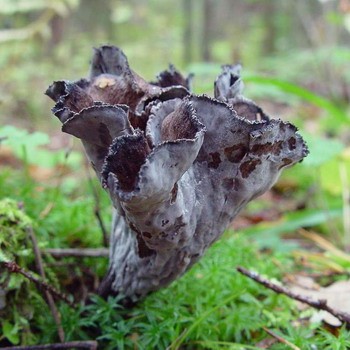 The edible fungus fungus (Craterellus cornucopioides) is ubiquitous in Our Country. It also grows in Europe, Asia and North America. The fruiting time of the mushroom is mid-July – late October.
The edible fungus fungus (Craterellus cornucopioides) is ubiquitous in Our Country. It also grows in Europe, Asia and North America. The fruiting time of the mushroom is mid-July – late October.
The hornwort can be found in deciduous and overhanging forests with high levels of moisture and calcareous soils, especially near oaks. It grows in large groups on rotten foliage and practically merges with it.
Other names: horn-shaped craterellus, funnel-shaped craterellus, funnel-shaped funnel, horn-shaped tube fungus, gray funnel. The peculiar shape of the horn-shaped funnel-worm was the reason for the appearance of the same original names in European languages: Finnish mustatorvisieni – “black horn”, German Totentrompete – “trumpet of the dead”, English Horn of Plenty and French Corne d’abondance – “cornucopia”.
Fruiting body of the gray funnel (height 4-15 cm): has the shape of a small cup, expanding from the bottom up. Almost everything is covered with small scales and tubercles. Craterellus horn-shaped has wavy, strongly outward-curving edges, which may be torn or stick out in separate flakes. Pay attention to the photo of the hornwort funnel: its inner surface is usually almost black or black-gray. The outside is a little lighter.
Leg (height 0,5-1,2 cm, diameter up to 1,5 cm): the same color as the cap, stiff and very small or almost absent.
Pulp: membranous, breaks from a slight touch. In young mushrooms it is dark gray, and in old mushrooms it is rich black.
Doubles: winding funnel (Craterellus sinuosus) and goblet urnula (Urnula craterium). The convoluted funnel is distinguished by a lighter color of the fruiting body and a more dissected cap, while the urnula does not have curved edges, and the shape is more goblet.
Application of craterellus funnelform
Hornwort fungus is a very tasty mushroom used in almost any type of dish. The use of funnel-shaped craterellus is especially widespread in Western Europe – here this mushroom is considered a real delicacy. In particular, in France it is added to gourmet sauces.
Application in traditional medicine: does not apply.









